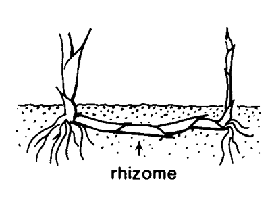Use this feature only to describe attached plants; do not use if your plant is floating and unattached. If you are unable to observe a plant's habit in situ, this can often still be inferred, particularly if you have the whole plant, including roots.
In this feature, more than one state may describe a specimen. For example, a stoloniferous plant may have basalbasal:
(adj) at or pertaining to the base, or point of attachment
rosettes at its nodes. Choose all states that apply.
The distinction between the states "creeping horizontal stem (rooting at nodes)" and "stoloniferous (bearing runners)" is not a sharp one. In general, in this tool, a stem is considered creeping if it is horizontal and leafy, especially between rooted nodes, while stolons are more easily recognized as such if they are not leafy between nodes, and bear basalbasal:
(adj) at or pertaining to the base, or point of attachment
rosettes at nodes. If you are uncertain, choose both states.
The above-ground prostrateprostrate:
(adj) growing closely along the ground
"stem" of ferns is called a rhizomerhizome:
(n) an underground stem, usually growing horizontally, from which both roots and shoots emerge directly; the thick, above-ground stem of ferns
 .
.